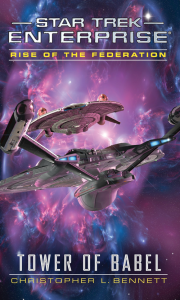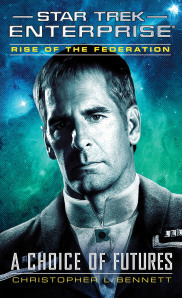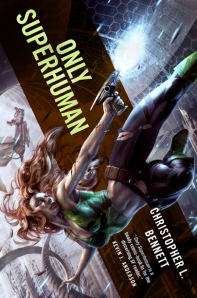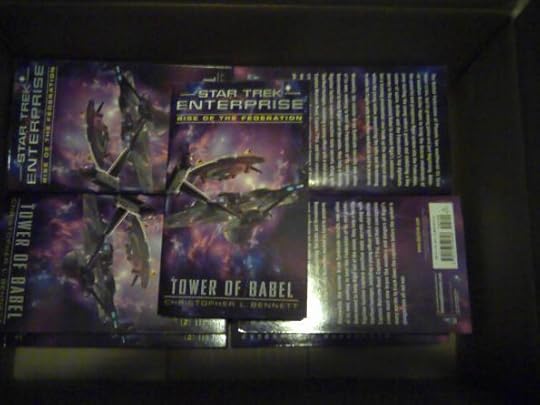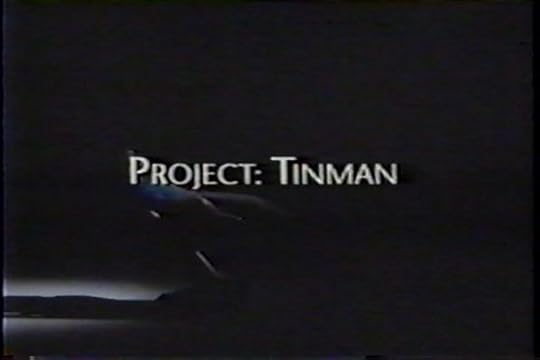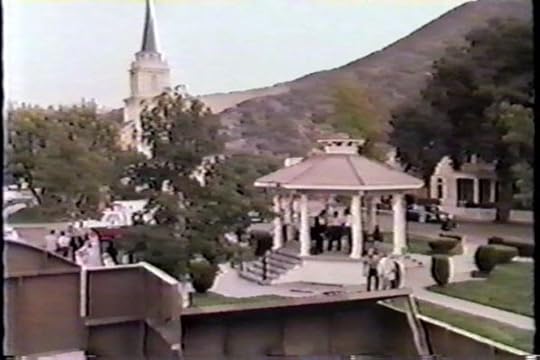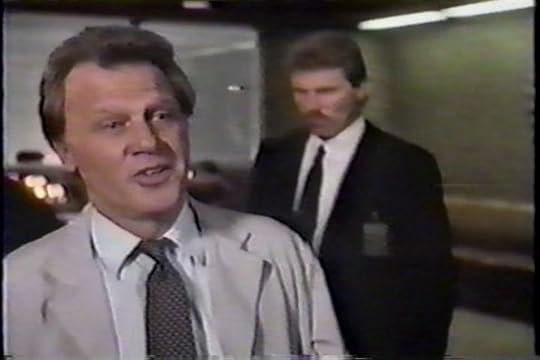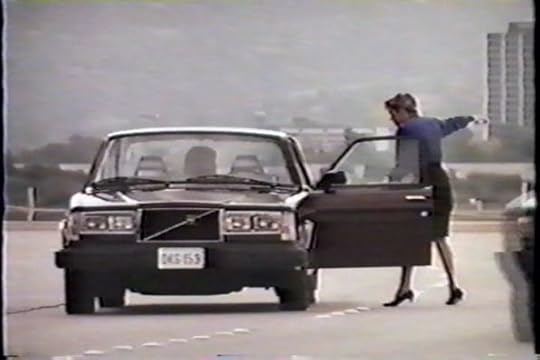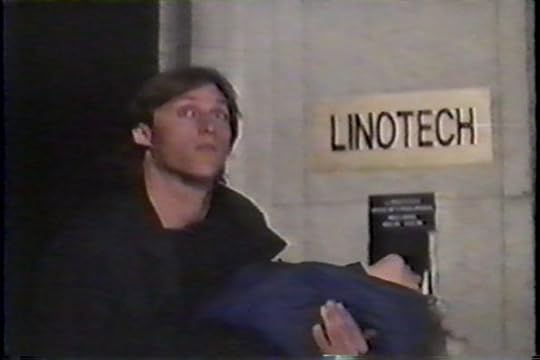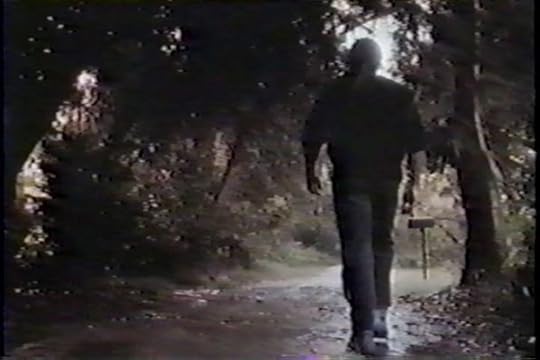Christopher L. Bennett's Blog, page 69
April 8, 2014
ROTF: TOWER OF BABEL annotations now up
Here are my annotations for Rise of the Federation: Tower of Babel, including a couple of excerpts from my project notes, one pertaining to the biology of one of the Rigelian species, the other being the historical overview of the Rigel system which I developed as backstory for the novel.
http://home.fuse.net/ChristopherLBennett/Trekfiction.html#ROTF2


April 2, 2014
New radio interview about my work
I recently did an interview for a radio show/podcast from New York’s WBAI radio called Equal Time for Freethought, talking about the scientific and philosophical ideas behind my works like Rise of the Federation: Tower of Babel and Only Superhuman and my view of the future. It can be heard here:
The interview portion begins at about 5:40 in the program.


April 1, 2014
Ohioana reception this Sunday at Cincinnati Public Library
Heads-up for folks in the Cincinnati area: This Sunday, April 6 from 1:30 to 4:00 PM, the Public Library of Cincinnati and Hamilton County will be hosting the annual Ohioana Library Association reception for local authors, including me. The program will include a panel discussion (which I don’t think I’ll be on) and individual recognition of the featured authors, and will be followed by a book fair where attendees can meet the various authors and buy autographed books. This is the second year of the book fair portion, and last year I didn’t sell any books, perhaps because I neglected to let anyone know in advance that the event was happening (blush). So this time I’m giving some advance notice. I’ll have a few copies of Star Trek: Enterprise — Rise of the Federation: Tower of Babel on sale, and I’m also thinking of bringing some copies of ROTF: A Choice of Futures and some of Only Superhuman.
And of course there will be plenty of other Ohio Valley authors with books of their own to sell and discuss. So if you’re in the area this Sunday, drop by the Main Library at 800 Vine Street in downtown Cincinnati. Although be aware that, while downtown parking is free on Sunday, there’s reportedly a lot of construction in the area so it may be hard to find. This page has directions and parking info.


March 19, 2014
First thoughts on The CW’s “The 100″ (spoiler review)
Disclaimer: I have no familiarity with the Kass Morgan novel The 100, on which the new TV series on The CW is based. I’m only assessing the show’s pilot based on the pilot itself.
And so far I’m very impressed. I think this is the best pilot I’ve seen on The CW in years. Okay, it’s a little rushed setting up the exposition at the beginning; I would’ve liked to see the situation on the Ark fleshed out a little more before the main characters were thrown into their situation. If this had been a movie-length pilot, they could’ve done so. But for whatever reason, those seem to have fallen out of favor these days. Given the time frame they had, the pilot was actually pretty well-paced, handling the exposition and character establishment efficiently and without too much awkward dialogue.
The premise is that a nuclear holocaust wiped out life on Earth 97 years before and the various orbital space stations housing the only survivors clumped together in “the Ark.” Conditions are draconian on the Ark due to limited resources and space, so any crime committed by anyone over 18 is a capital crime, both as a way of maintaining strict control and to keep the population size in check. But now The Ark’s life support systems are failing, so the leaders send their population of about 100 juvenile delinquents down to Earth, nominally to assess whether it’s habitable again and pave the way for the others’ return, but more immediately to give the Ark another month’s worth of life support. It explains why the survey party sent to Earth would be such an ill-suited group as a bunch of delinquent teens, since they weren’t really expected to survive or function effectively anyway — or at least that was secondary to the real purpose of sending them. So the Botany Bay-meets-Lord of the Flies scenario is reasonably plausible.
So far there’s pretty complex politics going on both on the Ark and on Earth, as factions jockey for power, and the motivations generally ring true. The clear villain up top is Councilman Kane (Henry Ian Cusick), who’s utterly ruthless in enforcing the letter of the law, but who genuinely seems to believe it’s necessary for the species’s survival. The heroine up top is Dr. Abigail Griffin (Paige Turco), who has a nice line when she says to Kane that she cares more about making sure we deserve to survive. I suppose I’ve seen that idea set up and delivered more effectively in other stories, perhaps, but it’s a sentiment I’m fond of, so I liked it here.
But the main story is down on the planet with the teens, the lead character being Abigail’s daughter Clarke Griffin (Eliza Taylor), who’s a natural leader, helper of others, and problem-solver, just the kind of person the 100 will need to survive — but of course these are delinquent teens, so not a lot of them have the good sense to follow her. And rabble-rouser and stowaway Bellamy Blake (Bobby Morley) encourages them to act up and misbehave, and to take off the bracelets sending vital-sign telemetry back up to the Ark so that the adults will think they’re dead and won’t follow them (the ship’s radio was trashed in the landing). He also apparently tried to assassinate the Ark’s chancellor (Isaiah Washington) and escaped to Earth, so he’s not a nice guy. But he has a motive for considering his actions self-righteous: his parents broke the law by having a second child, his sister Octavia (Marie Avgeropolous), who was thrown in prison for the crime of existing, and banished with the rest of the teens. (Odd that there aren’t any, you know, 11-year-0ld delinquents in the group. But then, maybe there’s been a ban on childbearing for the past 15 years or so, due to lack of resources?)
So there’s a lot going on, a nicely complex situation and a rather believable one, given the austerity that would be necessary for survival in a desperate situation like this. I do have trouble buying the idea of a global nuclear holocaust at all — it doesn’t seem as likely an apocalyptic scenario today as it would have 25 or more years ago. But allowing for that premise, the rest works pretty well — although some of the shots of the Ark itself are questionable from a physics standpoint. (I’m not sure the structure as shown would be stable given all the rotating sections, and if they’re using rotation for gravity, then the shot of Cusick staring out his window at a stationary vista of the Earth and another part of the Ark made no sense.)
And I really like the cast. It has a number of familiar and welcome faces like Paige Turco, Kelly Hu (adoring sigh), Alessandro Juliani, and a couple of familiar faces from Continuum, Terry Chen and Richard Harmon. (Gee, d’ya suppose it’s filmed in Vancouver?) Eliza Taylor is a very appealing lead; she has a really nice strong voice and conveys her character’s competence, charisma, intelligence, and emotion quite well. The other young leads are engaging as well, and Marie Avgeropolous is utterly gorgeous. The one thing that bugs me is that the core cast is disproportionately white; there’s good ethnic diversity in the supporting cast, but they’re still, well, supporting. Of maybe nine signfiicant players among the teens on the ground, there’s one central black character and one peripheral Asian character. On the Ark, though, it’s more even; the group of six significant adult players in the episode (Turco, Cusick, Hu, Chen, Washington, and Thomas McDonnell) was only half-white.
Still, overall I find The 100 quite engaging so far. I can’t remember the last time a CW show hooked me this thoroughly right off the bat. Even Arrow, currently their best genre show, took a while to become compelling after a merely decent pilot. I was lukewarm at first about their other new genre show this year, Star-Crossed, but it’s really started to intrigue me now that DS9/Andromeda veteran Robert Hewitt Wolfe has joined the writing staff. The central “alien Romeo and human Juliet” romance is kind of a dud so far, but the stuff around it gets more interesting every week. But it took a while to get there after a slow start. As for The Tomorrow People, I’ve been watching regularly but with little more than mild interest; the thing I like best about it is the theme music. And Madeleine Mantock. As for Beauty and the Beast, I’ve been so bored with it this season that I just started letting the episodes accumulate on my DVR for a few weeks and then realized I had no intention of ever watching them. And I don’t watch any of the vampire stuff, and I could never get into Supernatural because I find the leads uninteresting.
So I really hope The 100 can maintain the level of this pilot, or surpass it. I suppose there’s a lot about the “unsupervised sexy teen castaways in a mutated wilderness” premise that could go in a very hokey or gratuitous direction, but so far the storytelling and worldbuilding are effective and I’m eager to see more.


March 17, 2014
Brief excerpt from TOWER OF BABEL up on Amazon
Amazon’s page for Rise of the Federation: Tower of Babel has a brief excerpt up, toward the bottom of the page:
http://www.amazon.com/Star-Trek-Enterprise-Federation-Tower/dp/1476749647
At the moment it’s only a fragment of a scene, but maybe they’ll add more. In any case, the book’s nominal on-sale date is just over a week away. And I’ve gotten my own author copies:
More news as it unfolds. Sorry I haven’t been posting much, but I’ve been busy with a number of things.


February 25, 2014
Thoughts on the ROBOCOP reboot (spoilers)
I’ve talked in the past on this blog about my fondness for RoboCop: The Series and my opinions about the movies, so it seems appropriate to post my thoughts about the new movie version directed by José Padilha and starring Joel Kinnaman. I’ve seen mixed reviews, but it seems to be more popular with audiences than with critics, at least going by Rotten Tomatoes, so I figured it was worth a try.
I was never opposed to the idea of a RoboCop reboot; if anything, the issues of corporate power and robotic law enforcement are even more relevant today, so it seemed like a worthwhile and timely idea to revisit the concept in a way tailored to 2010s concerns rather than 1980s concerns. I wanted a film that would not try to copy the original, but would instead take the core concept in a distinct and fresh direction. Now, the last remake I saw of a Paul Verhoeven film, Len Wiseman’s 2012 Total Recall, was a big disappointment in that regard, superficially attempting something new but ultimately too slavish in its imitation of the forms of the original without the substance. So what I heard about this film’s fresh approach was encouraging.
And in that respect, I wasn’t disappointed. Padilha’s RoboCop is a radically different take on the premise, a more serious and realistic film than the comedy-satire Verhoeven made — perhaps fittingly, since its premise of a cyborg enforcer in a decayed Detroit is far closer to reality today than it was in 1987. Its version of Alex Murphy (Kinnaman) doesn’t even die; he’s just horribly injured and retains his identity and memories. And the story focuses more on his wife (Abbie Cornish) and son, and on the scientist who creates and mentors him, Dennett Norton (Gary Oldman), than on the criminals who attempted to kill him — although the machinations of the corporate executives led by Raymond Sellars (Michael Keaton) are about as prominent as in the original. It definitely meets the criterion of being a novel take. There are a couple of subtle nods, but they don’t get in the way of the new story being told: The Basil Poledouris theme is briefly heard at times; the original Rob Bottin costume design is glimpsed as a “combat mode” concept (and there are some nice echoes of Bottin’s classic work in the first version of Murphy’s armor); a character at one point says “I wouldn’t buy that for a dollar”; and there’s a variant on the original’s Directive 4, a program block prohibiting Murphy from turning on his corporate controllers, though it’s handled in a very different way (and Chekhov’s-Gunned in the opening sequence of the film). And the line “Dead or alive, you’re coming with me” is used, but in a way that cleverly inverts it and gives it new meaning. So even in those rare cases where it references the original, it doesn’t feel gratuitous or derivative. (Though I admit, I was a little disappointed that Murphy never said “Somewhere there is a crime happening.”)
It’s also a very well-made movie, with good designs and cinematography and convincing CGI, though a couple of the big action set pieces seem a bit video-gamey. The cast is solid and effective. (And as a fan of the TV series, I’m pleased that much of the location filming was done in Toronto, where R:TS was made.) I don’t get why they had to gender-swap Lewis (Michael K. Williams), but they also replaced Sgt. Reed with a female Chief Dean (Marianne Jean-Baptiste) and built up Mrs. Murphy’s role as well as giving prominent roles to Jennifer Ehle as Omnicorp’s legal executive and Aimee Garcia as Norton’s assistant, so I guess it balances out.
But is it a good story? I felt it was rather slow-paced in the first act, taking quite a long time to establish things that could’ve been handled more concisely. But I appreciated that increased level of detail when it came to delving into Murphy’s family life (in the original, we barely met him before he was killed) and into the mechanics of his rehabilitation and operations. Once it got into the meat of the story, it held my attention quite adequately through the end of the movie.
But after the movie, I began to realize some things were lacking. For a movie inspired by contemporary concerns about drone warfare and the surveillance state, it didn’t really do anything with those concerns. It set up a political conflict between a senator and his constituents who didn’t want unfeeling robots to wield deadly force on US soil and the corporation that sought to increase its profits by putting drones n the streets, but we never saw any actual negative consequences to individual liberty or safety once Murphy’s emotions were suppressed to let him operate in full-on drone mode. If anything, the movie presented ubiquitous surveillance as a pretty unambiguous positive, letting Robo track down bad guys in mere moments. (And it just now occurred to me to wonder, why couldn’t the rest of the police use the same tracking software?) The only people he endangers in emotionless drone mode are criminals and corrupt cops. The only negative consequences to Omnicorp’s progressive dehumanization of Murphy were the emotional consequences to Murphy himself and his family, and those prove pretty easy to overcome. So not only does the film not have much to say about the issues it superficially engages with, but it has little in the way of stakes. It tries to make Murphy the test case and linchpin for a national debate about drone warfare — played out through talk-show segments hosted by Samuel L. Jackson as the type of pundit of which Stephen Colbert is a parody — but it’s all just Greek-chorus exposition that doesn’t really connect to the small-scale story of Murphy and his family and doesn’t have any real payoff or impact. So the attempt at social commentary is all telling and no showing, and no clear point of view on the issues really comes across.
Also, Oldman’s Dr. Norton is somewhat unfocused as a character. He seems at first like a total do-gooder, but then is shown being willing to do some pretty nasty and dehumanizing things to Murphy in the name of Sellars’s profits, but then ends up on Murphy’s side once again in the final act. Maybe they were going for something about how easy it is for decent people to be persuaded to obey immoral orders, the Milgram experiment and all that, but Norton’s inner life isn’t examined enough for any such arc to become evident. It’s more like he’s just switching back and forth between two ethical states to serve the momentary needs of the script.
So in the end, I think all I can say about this movie is that it’s decent. It’s easily the second-best RoboCop movie, but only because the two sequels to the original were so weak. It’s an adequately well-told and extremely well-made story without a lot of substance to it. It’s nowhere near as good as the original — not because it’s different, since it should be different, but because it’s just not as interesting or clever or substantial. It’s worthwhile for the production values and the performances, and for the freshness of its take on the concept, but it had the potential to be so much more, potential that it never really embraced.


February 20, 2014
Questor addendum: PROJECT: TINMAN (1990)
Once upon a time, before home video and cable movie channels, network television showed movies in prime time. Usually it was either edited theatrical films or original TV movies. Occasionally, though, the slots would be used to burn off failed pilots — often two hourlong pilots shown back-to-back. By their nature, these rejected pilots usually weren’t all that good, but sometimes there were some interesting might-have-beens.
One such pilot, aired in 1990, was called Project: Tinman, and it interested me because it was along similar lines to Gene Roddenberry’s The Questor Tapes: An android protagonist fleeing the government, searching for his creator and the mysteries of his origin, and bonding with a human who helps him navigate the world. It also interested me because said human was played by the gorgeous Catherine Mary Stewart. Thus, I’ve kept it around, on the same VHS tape that contained my copy of Questor (or rather, the copy I just replaced with the legitimate DVD release, reviewed in my previous post). Now that I’ve begun archiving my old tapes on DVD-R, I’ve revisited Tinman for the first time in quite a few years. But I find it holds up more poorly than I remembered.
(Note: I don’t usually bother to include screencaps, but I’m doing it here for several reasons: One, because I can, now that it’s on DVD. Two, because it’s obscure and there can’t be many images of it out there. And three, I specifically wanted to show the title screen because I’ve seen the title misreported in various places, e.g. as Project: Tin Men. Unfortunately, my DVD-player program has flattened the aspect ratio on the screencaps to fit modern widescreen format, and I can’t figure out how to fix that, so I apologize for the distortion of the images.)
The android hero — called simply “The Man” on IMDb, though he briefly adopts the alias Daniel — is played by an actor with the improbably macho name of Hunt Block, who reminds me of a cross between Kevin Sorbo and Robert Hays in the Starman TV series. Apparently he was a pretty prominent soap-opera actor and more recently played the US president in Angelina Jolie’s Salt.
The pilot opens with a vaguely Clockwork Orange-y scene of The Man watching violent footage from films and cartoons (all from the Warner Bros. library, for they produced this) — although it’s not to desensitize him to violence but to train him for it. He walks out into Hazzard town square — err, the WB backlot — where Stewart’s Dr. Naomi Fischer (or Fisher?) is in a wedding dress, throwing her bouquet, which provokes a kid to run out into traffic and almost get run down by a speeding car before The Man — aw, heck, Daniel — saves her. The car is driven by a mad gunman who goes around shooting people at random, and Daniel spots a dropped gun and picks it up, with Naomi exhorting him to fire. But he can’t shoot, instead starting to sing “Frere Jacques” and passing out. Turns out the whole scene was a simulation to get the android to kill, and it failed. Nice use of the backlot as they reveal the rear of one of the building facades, exposing the illusion. But the whole thing seems kind of weird. Wouldn’t the government want him for military use? Why not simulate combat? And was the kid supposed to run out in traffic? What would’ve happened if they’d been more successful at eradicating Daniel’s regard for life?
Cut to exposition scene in dark, smoke-filled conference room, where it turns out the reason The Man can’t kill is that his creator, Dr. Robert Alan Craig, hardwired him with a moral sense. The government didn’t even build him, they stole him and wiped his memory, but couldn’t wipe his conscience. (This is another similarity to Questor: There, the android was built by a scientific consortium that didn’t understand the advanced work of its missing creator, and they’d inadvertently erased half his memory tapes. Here, it’s just a bit more sinister.) So they decide to shut him down, attempting to neutralize him by cutting off all light so he can’t recharge the solar cells in his palms. That’s actually kind of clever, a sensible way to deal with the risk that this superstrong, bullet-resistant android might fight back against annihilation. Except it’s combined with the totally non-sensible choice to leave his door unlocked so he could wander the base looking for light, then confront the project director, try to shoot him in self-defense, fail, and accidentally electrocute him anyway, then manage to flee to the outside just before his batteries run out.
After which the new project director, the chain-smoking Forrest (Leon Russom), fires Naomi, because apparently she disapproves of the project, even though we were shown no real sign of that before. It’s not clear why he wants her gone, except that they generally dislike each other — and except that it gives Daniel a way to smuggle himself out in her car, which the guards don’t bother to search even though the facility’s on total lockdown as they hunt for what they believe is a killer android. So, scorecard: one smart decision, two monumentally stupid ones. Advantage, stupidity. (Again, kind of like TQT, in that the android escapes with a human who’s mistrusted by the project’s leader. The details are quite different, though.)
Naomi isn’t pleased to find the killer android in her car, but a feeble “It was an accident?” is enough to convince her to take him home with her. The fact that she’s stopped in the middle of the road and almost gets run over is a factor too. Once at her implausibly palatial home, they start bonding, and she tells him the truth about his origins. And she lets her hair down for maximum hotness:
Yup, sure didn’t take long for those puppy-dog eyes and broad shoulders to win over this clear-headed scientist.
But Forrest has figured out the obvious and sends his security people to stately Fischer Manor. (Seriously, how many scientists make that kind of money?) Daniel speaks over the gate intercom in Forrest’s voice (edited from a conversation he overheard) to send them away, but that only works long enough for him and Naomi to make a break for it in her car. After they ditch pursuit, she suddenly wants him to hold her because she’s scared, and then they go to a bar and talk about his desire to find his creator and how she wishes it were that easy for her to get answers to her questions. It’s vaguely touching on the same “search for our creator” themes as Questor, but doesn’t examine them in any depth. Because it’s time for them to go to the supermarket so Daniel can have some cute “android puzzled by everyday items” bits, followed by a confrontation with the police (at least Forrest had the sense to put out an APB), in which he uses his glowy-palm interface to do something to the checkout scanner that magically causes every electrical device in the store to go crazy, up to and including the coffeepots spilling over. This is 1990. I doubt every item in the store is wirelessly networked. So how the hell did he do that?
They end up at the company where Craig worked — which just seems to be some fancy private home with a tech-company sign stuck by the front door — but find it’s vacant, its personnel fled because Forrest’s men were there first, although they’re gone now. They study Craig’s lab, and Naomi plays a tape of his music for some reason while Daniel discovers a video disc showing some of his “infancy” as Craig taught him like a child. Daniel recognizes a coded pattern that Craig meant for him to find in the music, even though Craig had no way of knowing that Naomi would be there and would randomly play the tape. It’s an exhortation from his creator to live up to his potential, saying that he’ll need help from others so he should help them in turn, and that he should reach for the light. Basically he’s advising Daniel to act like the protagonist in a Fugitive knockoff. So maybe you can see where this is going, especially once the pathetic-fallacy rainstorm starts up: Forrest’s people show up with snipers, Naomi throws herself in front of Daniel, Naomi gets shot…
…Naomi tells Daniel to run before the authorities arrive, Naomi dies, and Daniel walks off into the rain like Bill Bixby, albeit with a cheesy 1990 synth score instead of Joe Harnell’s piano.
Writing it out like that, I see it really is a lot worse than I remembered. It isn’t structured or developed all that well. The villains are blatantly cartoon evil with no ambiguity. The characters and their motivations are thinly drawn. Perhaps worst of all, The Man/Daniel doesn’t make a choice to be good. He doesn’t refuse to kill — he makes a sincere effort to become a murderer, but fails because of a hardwired prohibition, and isn’t at all bothered about killing the director by accident. He has no motivation beyond self-preservation; even Craig’s message tells him to help people so that they’ll help him in turn. He’s nice enough, even mildly charming, but he’s not heroic. Granted, Questor’s prohibition against killing was also a programmed block rather than a moral choice, but at least he has goals more altruistic than self-preservation — indeed, he’s quite willing to sacrifice himself to protect lives — and he has Jerry Robinson as a moral compass, a role Naomi doesn’t bother with and wouldn’t have been there to provide in a series. (The extent of her moral guidance is telling Daniel that people love Twinkies even though they’re lethal. And then eating one before she’s paid for it.)
And I’ve always felt that killing Naomi was a wasted opportunity. Not only would it have been a shame to lose the gorgeous Ms. Stewart, but she could’ve served the same role as Jerry in Questor or Jenny Hayden in Starman (or Scott Hayden in its TV sequel): the guide to humanity, a vehicle for commentary about human nature and discussion of the episodes’ themes. But I suppose they wanted to go the Fugitive route instead. I mentioned before that the reason The Questor Tapes was abandoned as a series was that the network wanted to write out Jerry and make Questor a solo hero on the run, adhering to the Fugitive formula, and Roddenberry refused, preferring to scrap the project altogether. Project: Tinman gives us a hint of what it would’ve been like had he given in. (Although it occurs to me now that Naomi’s death scene is ambiguous enough that she could’ve been easily enough revived for a series, if Stewart had been available and the producers so inclined.)
This pilot’s creator and writer, Lawrence Hertzog, went on to create another Fugitive-style series five years later: UPN’s Nowhere Man, a conspiracy-thriller series that was basically “Like The Prisoner, but with the whole country instead of one controlled village.” Which did not work at all for me, since it pretty much required that 95% of the entire United States population be complicit in the conspiracy against this one guy, a conspiracy that never really made sense anyway.
I’ve always wondered whether Hertzog was inspired by Questor, though it’s distinct enough to count as a variation on the theme, a second try at the format. Of course, it could be coincidence, since every story gets told more than once; there are only so many ways to put ideas and tropes together. Given the timing, The Man could’ve been inspired by Data, making its descent from Questor more indirect — although in that case it’d be quite a coincidence if it independently retroengineered something so close to the original story. But it’s definitely not as well-told as Questor was. It’s never ambiguous who the good guys and bad guys are, there’s no more than a passing attempt at philosophy, there’s no nuance to the characters, and the ending set up exactly the kind of formulaic continuation that Roddenberry killed his own series rather than settle for. I think I was so attached to this pilot because it felt to me like the closest thing we’d ever get to a continuation of Questor. But it really doesn’t hold up very well in comparison.


February 19, 2014
Gene Roddenberry’s THE QUESTOR TAPES
I finally got around to buying the print-on-demand DVD of Gene Roddenberry’s 1974 pilot The Questor Tapes, featuring the android character who would be the prototype for Star Trek: The Next Generation‘s Data. The reason it took me so long, after acquiring his Genesis II and Planet Earth pilots on DVD last year, is that I already had TQT on VHS tape and figured I’d use my VCR/DVD dubbing deck to archive it digitally. Now that I’ve actually found the time to begin transferring my old tapes, though, I realized my copy of TQT was way too low in quality — I’m pretty sure my VHS tape was copied in turn from a Beta recording off a TV movie — and that I’d be much better off paying for the inexpensive DVD release. Granted, the quality of that release isn’t that much better. It’s not remastered from the source, but is apparently just a reissue of a pay-TV edition, judging from the opening copyright disclaimer. Still, it’s the best we’ve got.
Questor was Roddenberry’s attempt to revisit the Kirk-Spock dynamic, with a logical, hyperintelligent lead character relying on the moral and emotional guidance of his human best friend. For the pilot, he brought in former Star Trek writer-producer Gene L. Coon to cowrite the script, which was a great choice, since Coon had a knack for writing close friendship between men. Batman producer Howie Horwitz is the credited producer (with Roddenberry as “executive consultant,” a title generally used for a creator who’s no longer in charge of the production), and the pilot was directed by Richard Colla, who would later direct the pilot movie of Battlestar Galactica.
The pilot is interesting in that it’s structured as a mystery revolving around the title character’s purpose for existence, creating a lot of ambiguity about who’s the good guy and who’s the bad guy. It opens at Cal Tech, where top scientists from five nations (evidently including the US, the USSR, China, France, and one other) have come together in Project Questor, an initiative to assemble a revolutionary android designed by the Nobel-winning Dr. Emil Vaslovik, who’s been missing and presumed dead for three years. It quickly becomes evident that nobody understands the advanced technologies underlying the android’s components, not even the lead assembler, Vaslovik’s protege Jerry Robinson (Mike Farrell). And the programming tapes Vaslovik left have been half-erased by the project’s attempts to decrypt them. At first, the programming seems to fail; the android remains inert. But that night — as project head Geoffrey Darro (John Vernon) is digging into Robinson’s background, suspicious that he may know more than he’s telling about Vaslovik’s intentions for the android — Questor himself awakens and gives his smooth plastic form a makeover using the project’s equipment, turning himself into Robert Foxworth. It’s actually a very clever effect — in continuous shots, we see the equipment removing the “robot” makeup and revealing Foxworth’s features underneath, creating the illusion that it’s actually molding those features onto the mannequin-like form. I’d forgotten that these scenes have a horror-movie quality, since at this point the audience has no way to know whether Questor is the hero or the villain.
Indeed, his actions are quite morally ambiguous at first. Once he breaks out of the lab, he forces a terrified Jerry to come with him, although it gradually becomes clear that he is programmed to be incapable of killing. Still, Jerry convinces Questor to accede to his guidance on matters of morality. Although he lets that slip a bit when they get to a casino in Universal-backlot London and Questor uses his computer senses to cheat at craps in order to obtain “specie,” as he keeps calling it. Virtually this same sequence, right down to the android using his superstrength to unload a pair of loaded dice, was later reused with Data in TNG’s “The Royale.”
Questor remembers enough about Vaslovik’s past to lead him to the home of Lady Helena Trimble (Dana Wynter), a prominent socialite and alleged courtesan,who turns out to be an information broker who worked with Vaslovik, leading Jerry to suspect that Questor may have been built for espionage purposes or worse. Especially once he discovers the secret information center where Questor, like Vaslovik before him, can monitor spy images and sensitive secrets from all over the world, possibly affecting millions of lives. Helena insists the motives behind this technology are benevolent, but Jerry has already called in Darro. Will his trust in Questor’s friendship win out over his doubts, and can Questor win over the cynical Darro to their side?
Spoiler alert: The movie climaxes at Mt. Ararat, where we learn that Vaslovik was himself an android, the latest in a line of androids who’ve been subtly guiding and safeguarding humanity for 200,000 years. Their mission is not to control us, but only to assist us to make our own decisions. But Questor is the last; if humanity survives to the end of his 200-year lifespan, it will have outgrown its childhood and won’t need a nanny anymore.
I think the pilot still holds up pretty well, although it’s not perfect. Foxworth’s jerky line delivery as Questor is a bit annoying after a while, although it gradually softens over the course of the movie. The Questor-Jerry relationship maybe develops a bit too quickly, but the same can be said of many TV relationships; a certain amount of shorthand is just part of the form. And some of the dialogue doesn’t flow as smoothly or logically as it could, and there are some abrupt transitions. It feels like a fair amount was cut out, although the running time on the DVD (96 minutes) is consistent with what the runtime for a movie in a 2-hour time slot would’ve been in 1973, so the cuts would’ve been in the original.
Still, Foxworth, Farrell, and Vernon are strong leads, and the core relationship is pretty solid — inspired by Kirk and Spock, but different enough to be fresh. Jerry is no Kirk, particularly not where women are concerned; at one point, Questor encourages him to seduce Lady Helena for information, but he’s terrible at it and can’t bring himself to use her that way. And Questor, much like Data, is rather the opposite of Spock: lacking the inbuilt potential for emotion (part of what was erased from the programming tapes) but eager to learn more about how to be human. The suspense over the purpose and morals of Questor’s creation is interesting, although resolved a bit too easily. And I kind of like it that there’s no villain in the story, just people with conflicting views and goals, doing what they think is right.
And there’s a lot here that seeded later SF productions. I’ve mentioned Questor as the inspiration for Data. Also, the music cue that composer Gil Melle uses in the Project Questor lab scenes would be repurposed later that year as the theme for Kolchak: The Night Stalker. And when Questor finds Vaslovik’s Mt. Ararat lair, the device that “heals” him and infuses him with his missing knowledge makes the same “ta-ta-tang” sound effect (albeit truncated) that would later become the trademark sound of The Six Million Dollar Man and The Bionic Woman (also from Universal).
The sad thing about TQT is that it almost became a series. As detailed in this excellent overview article (no longer “live” but preserved in the Internet Archive), a season of the show was actually commissioned, but the executives insisted on changes to make it more like The Fugitive — drop Jerry, ignore the ending where Questor found his answers, and have him be a lone hero on the run from the authorities. Apparently they wanted the benign-intervention angle dropped, uneasy with the idea of alien androids playing God — which I think was unfair, because the movie made it clear that Questor’s interventions were meant to be rather subtle. Rather than cave to network pressure, Roddenberry walked away from the show altogether, killing the project. This one movie is all we got. Although maybe that’s just as well, if the only alternative was to see a watered-down version that eliminated the core relationship and the core premise. (Said premise itself being Roddenberry’s latest attempt at the “aliens secretly guiding humans” premise from his Star Trek backdoor pilot episode “Assignment: Earth.”)
There was an attempt to reboot the series in the early 2000s, under the guidance of Herbert J. Wright, a former TNG producer who’d been attached to the abortive 1974 Questor series. Unfortunately, Wright passed away in 2005 and the project fell through. The rights are currently held by Imagine Entertainment, and in 2010 there was talk about a reimagining to be developed by Tim Minear; but nothing seems to have come of it. They keep trying, but they just can’t seem to get it off the ground.
Foxworth would later go on to play two major villains in the Trek franchise: Admiral Leyton in Deep Space Nine‘s “Homefront”/”Paradise Lost,” and Administrator V’Las in Enterprise‘s Vulcan Civil War trilogy. Farrell would never appear in another Trek or Roddenberry-related production, nor would Vernon. However, the pilot features a couple of Trek veterans in bit roles at the Project: Majel Barrett (who was in every Roddenberry production from TOS onward) as Dr. Bradley, one of the scientists, and Walter Koenig (unrecognizable under a Sonny Bono-ish hairdo and mustache) as Darro’s assistant Phillips. The matte paintings and visual effects in the movie were done by the great matte artist Albert Whitlock, who had previously done the matte paintings for TOS. (His paintings do enhance the “Ararat” location, but there are enough moving shots to make it clear that the featured mountain peak is real; I just wish I could find out where it was. It looks nothing like the real Mt. Ararat, but is extremely striking.)
—
Despite the abandonment of the series, the pilot got a novelization by Roddenberry’s former Trek colleague D.C. Fontana — the only novel on her resume other than Star Trek: Vulcan’s Glory, although oddly the front matter of the book credits her with a Ballantine title called The Winds of Space, which was actually the title of a TV pilot that Fontana reportedly had in development around 1972-3. Perhaps there was a plan for her to novelize the pilot script, but it fell through.
Although it was Fontana’s first novel, it reads pretty well. It’s quite faithful to the script for the most part, but it adds a lot of material that fleshes out the story considerably and fills in a lot of the gaps in the movie. Notably, there’s a new thread of intrigue as the various nations partnering in Project Questor are all eager to get possession of the technology for themselves and trying to co-opt or bribe Jerry into selling out to them. It helps raise the stakes and helps explain why Darro is so concerned about Questor falling into the wrong hands. We learn a lot more about Lady Helena and Dr. Vaslovik, and there’s an added subplot about Questor using his precise computer projections to play the stock market and make millions by buying and selling at exactly the right moments — somewhat prophetic, I think, given how much stock trading today is dependent on computers. Although it clashes a bit with the movie plot, since the reason Questor suggested that Jerry seduce Helena was because they didn’t have the means to pay her. Fontana doesn’t provide a suitable alternative motivation for the wealthy Questor of the novel to suggest seduction.
The biggest departure from the movie is in the third act. The movie gives Questor a deadline of three days (after their time at Helena’s) to find Vaslovik, or something terrible will happen, and he figures out Vaslovik’s location just before he’s recaptured by Darro’s men. In the book, though, the deadline is extended to seven days, and he doesn’t get the vital clue before his recapture. Instead, there’s a sequence where he’s given the resources and personnel needed to attempt to track down Vaslovik — which seems a rather pointless addition, since after days of futile searching, he ultimately ends up getting the vital clue in the same coincidental way he did in the movie. It’s the one part of the novel that feels like it serves no purpose beyond padding the word count.
But it’s also just about the only part that doesn’t feel like an improvement. Although the novel is long out of print and much harder to track down these days than the DVD, I recommend it as a valuable supplement to the film. Some parts of it should be taken with a grain of salt, but others enhance the “reality” of the film considerably.
—
In my Genesis II/Planet Earth review, I talked about how I choose to interpret them as an alternate timeline of the Trek universe. But I’ve always liked to think that Questor actually took place in the Trek universe itself — and that maybe Data’s creator Noonien Soong learned some of what he knew about androids from Questor somehow. (Although a direct lineage doesn’t work, because Questor’s brain was based on something called “bionic plasma” rather than a positronic matrix.) Of course, since TQT was from Universal, that can never be officially asserted, but there have been several references in various Trek novels implying that Questor may have existed in that universe:
In Greg Cox’s Assignment: Eternity, Roberta Lincoln reminisces about helping Gary Seven retrieve some secret robot plans called “The Quasar Tapes, or something like that.” Roberta recalls that they were in the Pentagon rather than Cal Tech, but that still fits; maybe the Pentagon stole the plans from Vaslovik, and Gary and Roberta got them back into civilian hands.
In Jeffrey Lang’s Immortal Coil — and its followup, the Cold Equations trilogy by David Mack — we see that Flint, the immortal android-builder from “Requiem for Methuselah,” would live on into the 24th century and adopt the pseudonym Emil Vaslovik, becoming a mentor to Noonien Soong. There’s no mention that Vaslovik was the name of a real historical figure — indeed, given that TQT’s Vaslovik was a famous Nobel laureate, it might’ve been a bad idea for Flint to choose such a conspicuous pseudonym — but it’s possible to fudge things and surmise that Flint had known Vaslovik and/or Questor back in the 20th century and learned about androids from them.
And I’ve followed their lead and inserted a reference in my own work: in Watching the Clock, a member of Gary Seven’s Aegis organization refers to “those damn androids” as if they were the competition. And there’s another very subtle nod coming up in my DTI eBook The Collectors.
Although that competition thing is the main problem with having Questor in the Trek universe: aren’t he and Gary Seven basically doing the same thing? And since Gary and Roberta have been doing it six years longer, are Questor’s efforts even necessary? But seeing the movie again, I’m thinking maybe they don’t overlap that much. We know that Gary’s mission was to prevent humanity from destroying itself as it moved through the era of its greatest crisis. So he and Roberta are dealing fate-of-the-world stuff. By contrast, the Vaslovik androids are on a much subtler mission, just guiding and protecting human beings who have the potential to do good and make the world better — not making their decisions for them, but helping them survive or get the education or resources or opportunities they need to fulfill their potential. Maybe speaking a word in the right ear, as Questor puts it, to nudge someone in the right direction. They’ve been at it since the dawn of Homo sapiens‘ existence as a distinct species, and while there have been times in that 200,000-year span when we were at risk of extinction, it probably hasn’t been a concern for most of that span — or at least it wasn’t something that could’ve been affected by the ability to influence human decisions, not until the nuclear age. So maybe Questor’s activities are on a small enough scale that Gary’s activities don’t render them redundant. They could have even complemented each other, with Gary and Roberta tackling the big crises and Questor and Jerry and Helena helping out the little guys who fell through the cracks. Maybe that’s why Gary wanted to make sure the Questor Tapes ended up in the right hands.
Of course, that idea is somewhat dependent on the fact that neither show went past the pilot stage. If both shows had been made, they might have ended up telling fairly similar stories — and of course neither would’ve acknowledged the other. But then, if A:E had been made, Roddenberry wouldn’t have tried to revive the concept with Questor anyway. As it is, though, we’re free to fill in the gaps and imagine what might have been.


February 17, 2014
Let me count the words
I realized it’s been nearly three years since I last posted a list of the word counts of my published works. I’m curious to see how much I’ve added since then. This is counting everything I’ve sold and finished writing to date, so there are a couple that haven’t yet been published.
ORIGINAL NOVELS
Only Superhuman: 115,000
ORIGINAL SHORT FICTION
“Aggravated Vehicular Genocide”: 12,000 words
“Among the Wild Cybers of Cybele”: 9400
“The Hub of the Matter”: 9300
“The Weight of Silence”: 7600
“No Dominion”: 7900
“Home is Where the Hub Is”: 9800
“Make Hub, Not War”: 9800
Total original fiction count: 180,800 words
MARVEL NOVELS
X-Men: Watchers on the Walls: 83,500
Spider-Man: Drowned in Thunder: 71,000
Total Marvel novel count: 154,500 words
STAR TREK NOVELS
Ex Machina: 110,000
Orion’s Hounds: 105,000
The Buried Age: 132,000
Places of Exile: 55,000
Greater Than the Sum: 78,500
Over a Torrent Sea: 89,000
Watching the Clock: 125,000
Forgotten History: 85,500
A Choice of Futures: 80,500
Tower of Babel (pending): 84,000
Total ST novel count: 944,500 words
STAR TREK SHORT FICTION
“Aftermath”: 26,000
“…Lov’d I Not Honor More “: 12,000
“Brief Candle”: 9800
“As Others See Us”: 9100
Mere Anarchy: “The Darkness Drops Again”: 28,900
“Friends With the Sparrows”: 10,300
“Empathy”: 11,000
Typhon Pact: “The Struggle Within”: 25,000
“The Collectors” (pending): 35,000
Total ST short fiction count: 167,100 words
STAR TREK MAGAZINE ARTICLES
“Points of Contention”: 1040
“Catsuits are Irrelevant”: 1250
“Top 10 Villains #8: Shinzon”: 820
“Almost a Completely New Enterprise”: 800
“The Remaking of Star Trek“: 1350
“Vulcan Special: T’Pau”: 910
“The Ultimate Guide: Star Trek: Voyager Season 3″: 1170 (not counting episode guide)
“”Star Trek 45s #11: Concerning Flight”: 1000
Total article count: 8340 words (Counting only paid articles — excluding articles written for websites)
All told:
Novels: 1,214,000 words
Short fiction: 347,900 words
Nonfiction: 8,340 words
Total fiction: 1,561,900 words
Total overall: 1,570,240 words
So since last time, I’m up 365,000 words in novels, I’ve more than doubled my short fiction count, and I’ve gained a measly 2,170 words in paid articles. In total, in the past three years, I’ve increased my published (or soon-to-be-published) word count by over 50 percent!
Note that I’ve now written over 1 million words of published (or nearly-published) Star Trek fiction. My next novel, Rise of the Federation: Uncertain Logic — which I’ve just been cleared by CBS to begin writing — is contracted to be 80-100,000 words, so that will put me over a million words in Star Trek novels alone. That’s one more milestone to look forward to.


February 16, 2014
He’s got a TV in every room…
Well, not anymore. For many years, I’ve had a small TV in my bedroom, equipped with an antenna (no cable hookup) and attached to a VCR. But a few years ago, the broadcast stations switched to digital and I didn’t bother to buy a converter; I figured I’d just keep the TV around if I wanted to watch a tape before going to sleep or something. But I hardly ever did that (I prefer to read before bed), and the VCR doesn’t work well anymore — the playback head seems dirty or corroded and I have nothing to clean it with. So the whole thing was basically taking up space. But I’m a pack rat by nature, loath to get rid of things in my possession and preferring to keep them around “just in case.” So I just left the TV and VCR where they were, atop my dresser.
Yesterday morning, though, the thought finally overcame my mental inertia: Why do I even keep them plugged in if I don’t use them? I don’t even bother to set the VCR clock, since there’s a clock radio right next to it. Having them plugged in may have only used up a trickle of power, but it added up over time. So I figured I might as well unplug them until or unless I had reason to use them. So once I’d done that yesterday morning, it only took until afternoon for me to take the next step: If they’re unplugged now and just taking up space, why not just put them in the closet and clear up some much-needed surface area in my bedroom? So I did that, and I moved a crate which I use as a bookshelf into the vacant space, which cleared up some room to rig a couple of makeshift bookshelves where the crate had been (one out of a cardboard box with its flaps duct-taped back, one out of a plastic drawer I recovered and cleaned from someone’s curbside trash, which is almost exactly the same size as the box), and that let me ease the overcrowding on the bookshelves for my general SF/fantasy/other paperbacks.
But that got me looking at the other bookshelves I have on top of the general-SF bookcase, the shelves where I keep my non-Star Trek tie-in books, mostly a whole bunch of Target Doctor Who novelizations from way back. (I used to have a comprehensive collection, though eventually I got rid of many of them, keeping only the novelizations of stories I liked and all the missing stories. But it’s still a pretty sizeable collection.) The main case I use there is one of a pair of cardboard bookcases, printed with a wood grain pattern, that I realize I’ve had for over 30 years. Each of the cases has three shelves, the top two of which are just tall enough to hold paperbacks and the third of which is just tall enough for standard hardcovers or trade paperbacks. The problem, though, is that I mostly just have standard paperbacks in the bottom shelf, and an extra row of paperbacks on top of the case adding weight, so one of the sides of the case is buckling at the bottom and the structural stability of the unit is compromised.
So clearly I need a new bookcase to put there, but my search online has been unproductive. Bookcases are expensive, more than I’m comfortable spending right now. And I can’t find anything like those cardboard bookcases. I found one site that seemed too good to be true, offering a 3-foot by 3-foot oak bookcase for under 15 bucks when it was normally sold for over 200 bucks — but then I found out that the catch is that the shipping cost is nearly 150 bucks. So much for that idea.
Maybe the problem is that people don’t read as much anymore. Perhaps I should be looking into DVD shelving instead, since DVD cases are a little taller than paperbacks.
Anyway, I’m just glad I’ve finally made at least a small start at rearranging my bedroom. I get tired of living in the same unchanging environment after a while, and I’ve been in this apartment over 10 years now. Sometimes I look sideways into my bedroom mirror to see the reflection of the room, and I always think “Wow, that room looks so much nicer than mine.” Because it’s different. When I was younger, I’d periodically find ways to rearrange my existing furniture and bring some novelty to the space I inhabited. Unfortunately, the layout of my apartment and the configuration of my furniture leaves me very few options for rearranging things. Even making a small change is rewarding. I just hope I can solve the bookcase problem before I have a collapse.



